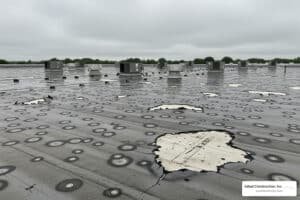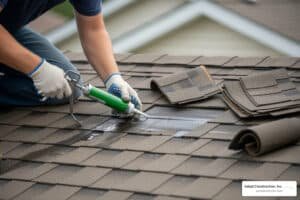
When Hailstorms Strike: Your Path to Professional Roof Recovery
When hailstones pummel your roof, they can cause immediate visible damage like dents and cracks, as well as hidden issues that may not surface until the next heavy rainstorm. Hail damage roof repair is a critical service that can save your home from thousands in future water damage. For nearly three decades, Adept Construction, Inc. has provided expert hail damage roof repair for Illinois homeowners, helping them steer the challenges with confidence.
Quick Answer: Essential Steps for Hail Damage Roof Repair
- Inspect safely – Check for damage from the ground first.
- Document everything – Take photos and videos for insurance.
- Contact your insurance – File a claim promptly.
- Get professional assessment – Hire licensed contractors for a thorough inspection.
- Choose repair vs. replacement – Base the decision on damage extent and roof age.
- Select quality materials – Consider Class 4 impact-resistant shingles.
Getting a professional storm damage assessment quickly is crucial. Hailstones as small as one inch in diameter can cause significant damage, especially with strong winds. What appears as minor cosmetic damage can compromise your roof’s integrity, leading to leaks, mold, and structural issues. The hidden danger is that even small impacts weaken shingles, and insurance companies typically require claims to be filed within six months to two years, making prompt action essential.
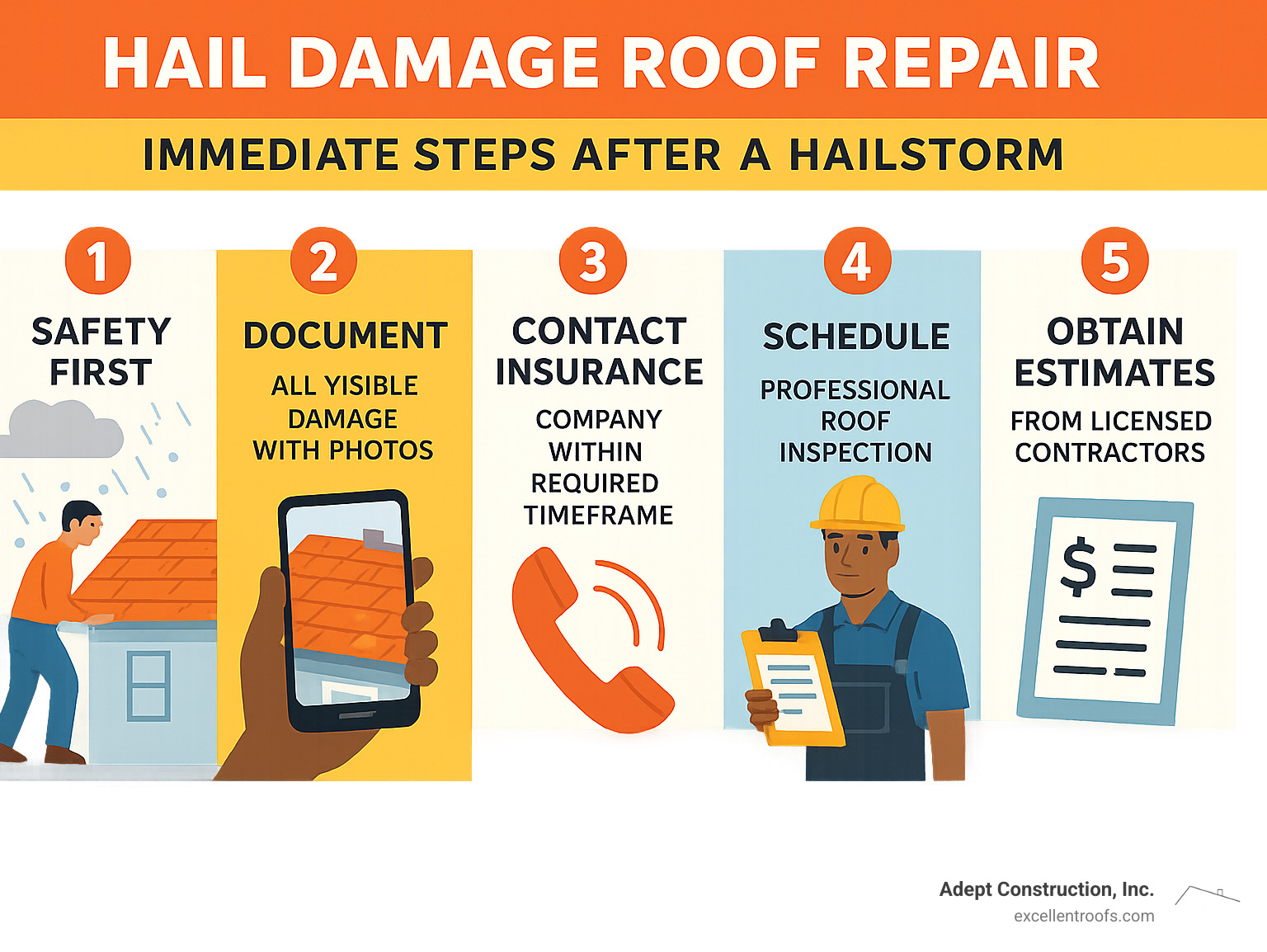
As the founder of Adept Construction, Inc., I’ve seen how a swift, professional response can protect a home. Since 1997, our team has specialized in residential and commercial roofing, earning trust through superior workmanship across Chicago’s suburbs. For trusted guidance, contact our roofing experts for a free estimate.
Identifying Hail Damage: A Post-Storm Inspection Checklist
After a hailstorm, your first instinct might be to climb onto the roof. Don’t! Wet or damaged surfaces are dangerously slippery. Instead, use this checklist to assess your hail damage roof repair needs safely from the ground before calling for a professional assessment. Think of yourself as a detective gathering evidence—every dent tells part of the story.
Signs of Damage from the Ground
Start your investigation on solid ground, using binoculars for a closer look. You can find a surprising amount of evidence this way.
- Gutters and Downspouts: Look for fresh dents, dings, or scuff marks on metal gutters. If they look beat up, your roof likely took some hits too.
- Granule Accumulation: Check inside gutters and around downspout outlets for an unusual amount of shingle granules. These tiny, pebble-like particles are your shingles’ protective armor. Finding them is a clear sign of hail impact.
- Siding and Windows: Check for dents, cracks, or chips on vinyl siding, window casings, and screens. Hail doesn’t discriminate; damage here suggests roof damage as well.
- Other Property: Your air conditioning unit, mailbox, and deck railings can also serve as indicators. If they show signs of impact, your roof probably does too.
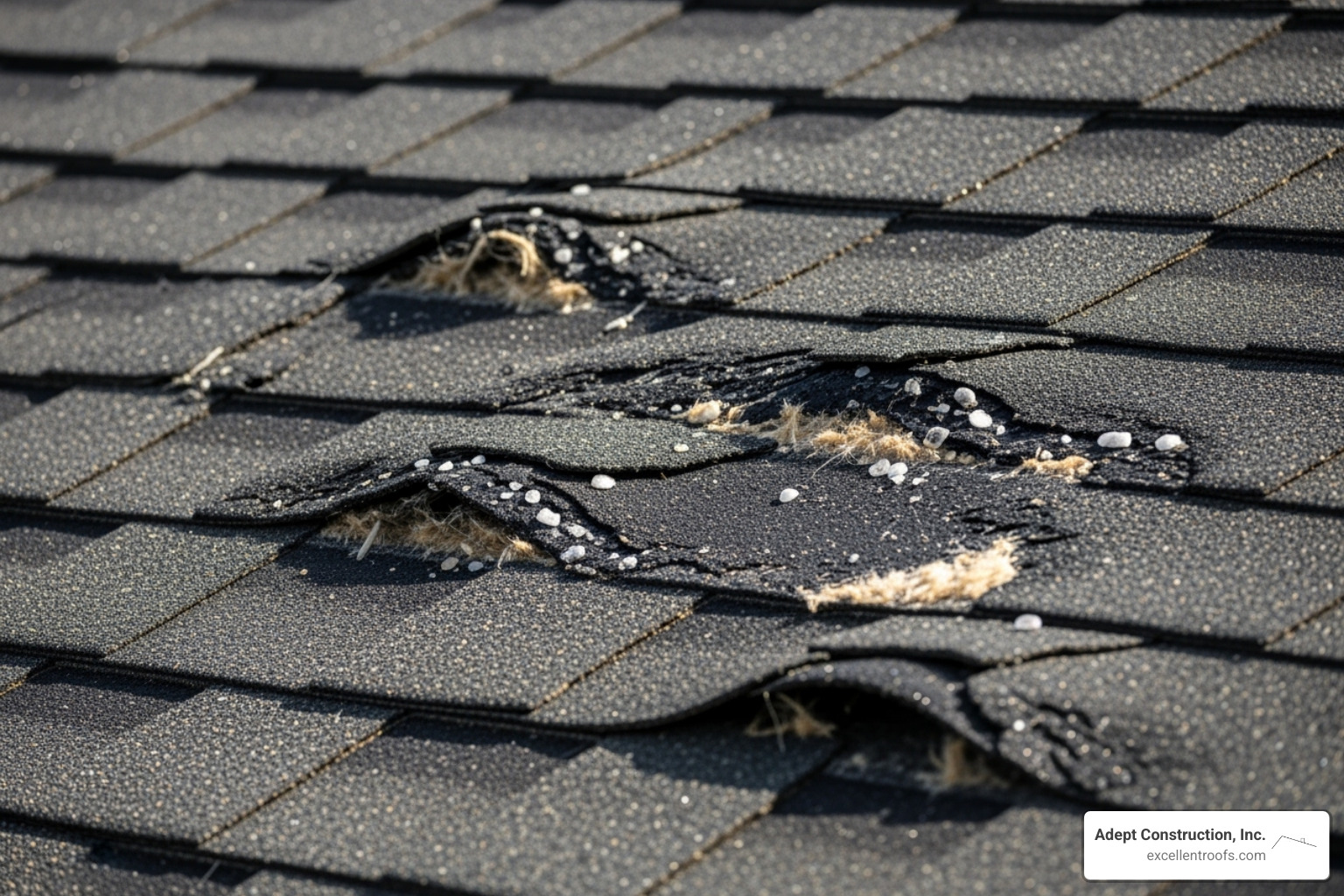
How to Spot Hail Damage on Your Roof
While a ground inspection provides clues, understanding what damage looks like on different materials helps you communicate with contractors and adjusters. For a visual guide, see our article on how to spot hail damage on your roof.
- Asphalt Shingles: This is the most common damage we see. Look for granule loss, which leaves exposed, dark spots that accelerate aging. Bruising is harder to spot; the shingle may feel soft or spongy, indicating internal damage. Also, look for cracks and splits that create openings for water.
- Wood Shakes: Hail creates fresh, sharp-edged splits, unlike the rounded splits from natural weathering.
- Composite and Tile: These materials can chip, crack, or break. Large hailstones can even dislodge tiles completely.
- Metal Roofs: Dents and dings are common. While often cosmetic, severe impacts can cause creasing or punctures.
Even experienced homeowners can miss subtle hail damage. What looks minor can hide serious issues. That’s why getting a professional assessment, like a roof repair evaluation in Naperville, IL, is so important. Trained eyes can spot problems before they lead to expensive leaks, mold, and rot.
Understanding the Severity: How Hail Size and Other Factors Affect Your Roof
Not all hailstorms are equal. The difference between a minor repair and a complete roof replacement often comes down to several key factors. Understanding these variables helps you assess the urgency of your hail damage roof repair needs.
The Role of Hail Size and Wind
Hail size is a primary indicator of potential damage, but wind is a critical multiplier. A 1-inch hailstone driven by 60 mph winds hits with much greater force than one falling straight down.
- Pea to Grape Size (up to 3/4″): Typically causes minor cosmetic damage, but repeated storms can wear down protective shingle granules.
- Golf Ball Size (up to 1 3/4″): This is where real damage begins. Hail of this size can bruise shingle underlayment, knock granules loose, and dent gutters and siding.
- Tennis Ball to Baseball Size (2″ and larger): This is a serious event. Hail this large can crack or puncture shingles and decking, leading to immediate and severe leaks. If you’ve experienced hail this size, you need an emergency storm damage assessment.
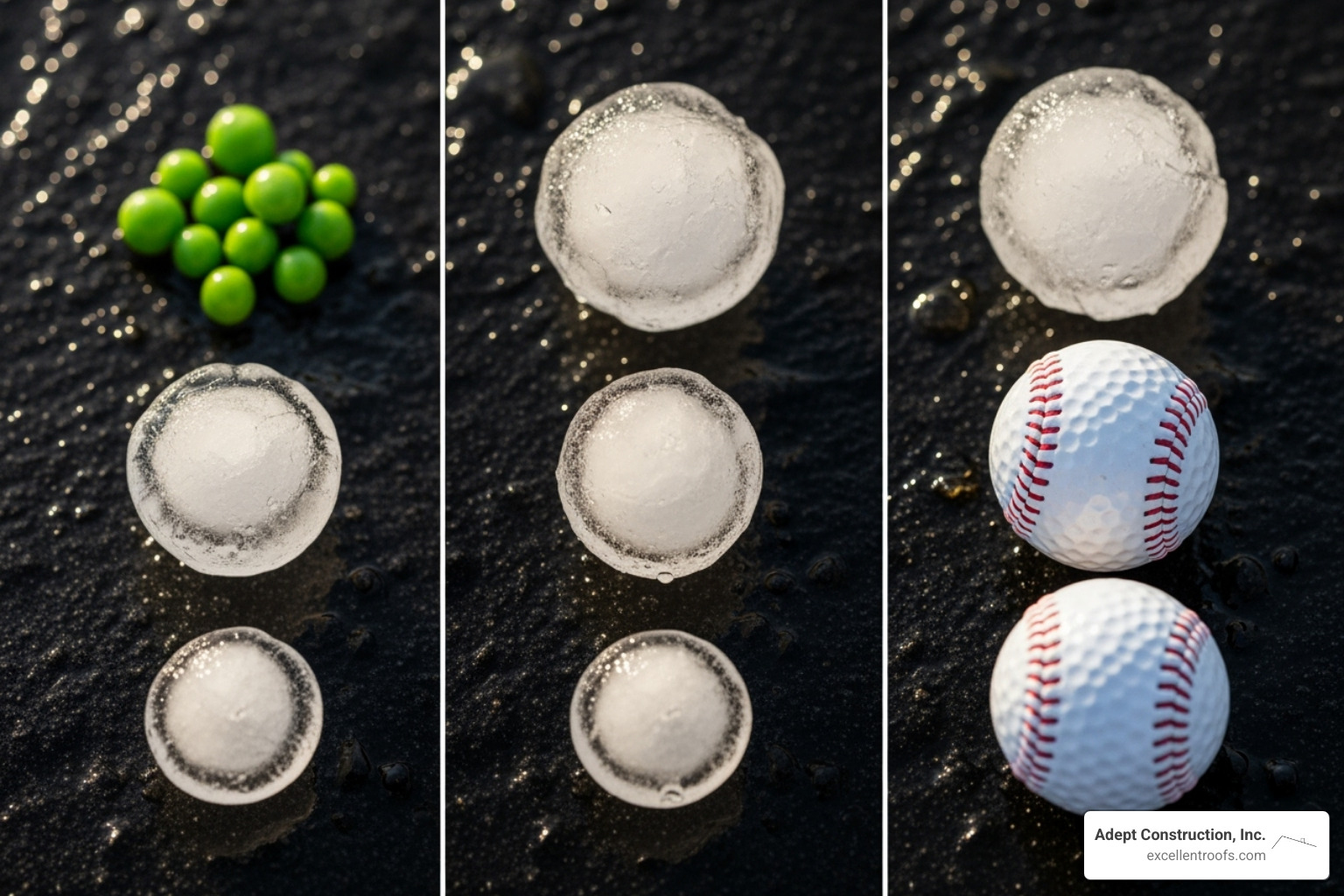
Your roof’s age, slope, and material also play a crucial role. Older, brittle shingles are more susceptible to shattering than new ones. The science behind hail formation from NOAA explains how these destructive ice balls are created in severe thunderstorms.
Long-Term Consequences of Ignoring Damage
What looks like minor damage today can become a homeowner’s worst nightmare. Ignoring hail damage leads to a cascade of expensive problems:
- Water Leaks: Tiny cracks or bruised spots allow water to seep in, staining ceilings and damaging interiors.
- Mold Growth: Damp conditions in your attic create a perfect breeding ground for mold, which can cause health issues.
- Structural Rot: Persistent moisture can rot your roof deck and framing, compromising your home’s integrity.
- Higher Energy Bills: Wet insulation loses its effectiveness, forcing your HVAC system to work harder.
- Accelerated Aging: Exposed asphalt on shingles breaks down under UV rays, cutting years off your roof’s lifespan.
Prompt repairs are far cheaper than dealing with these consequences. Our guide on the Top Signs Your Roof Needs Immediate Repair After a Storm can help you identify issues before they escalate.
Navigating Insurance Claims and the Cost of Hail Damage Roof Repair
Dealing with insurance claims and unexpected bills is stressful. This section breaks down the financial landscape of hail damage roof repair costs and the insurance process to help you steer the challenge with confidence.
Average Cost of Hail Damage Roof Repair
The cost of hail damage roof repair varies based on damage extent and materials. Minor repairs might cost a few hundred dollars, while a full replacement can reach $25,000 or more. The average project falls between $1,500 and $10,000.
- Asphalt Shingles: $3 to $10 per square foot for extensive repairs.
- Metal Roofing: $5 to $18 per square foot for major repairs.
- Clay or Concrete Tiles: $5 to $18 per square foot for extensive work.
- Wood Shingles: $6 to $7 per square foot to repair.
Labor costs typically run $45 to $75 per hour. Associated costs like water damage remediation or mold removal can add to the total bill.
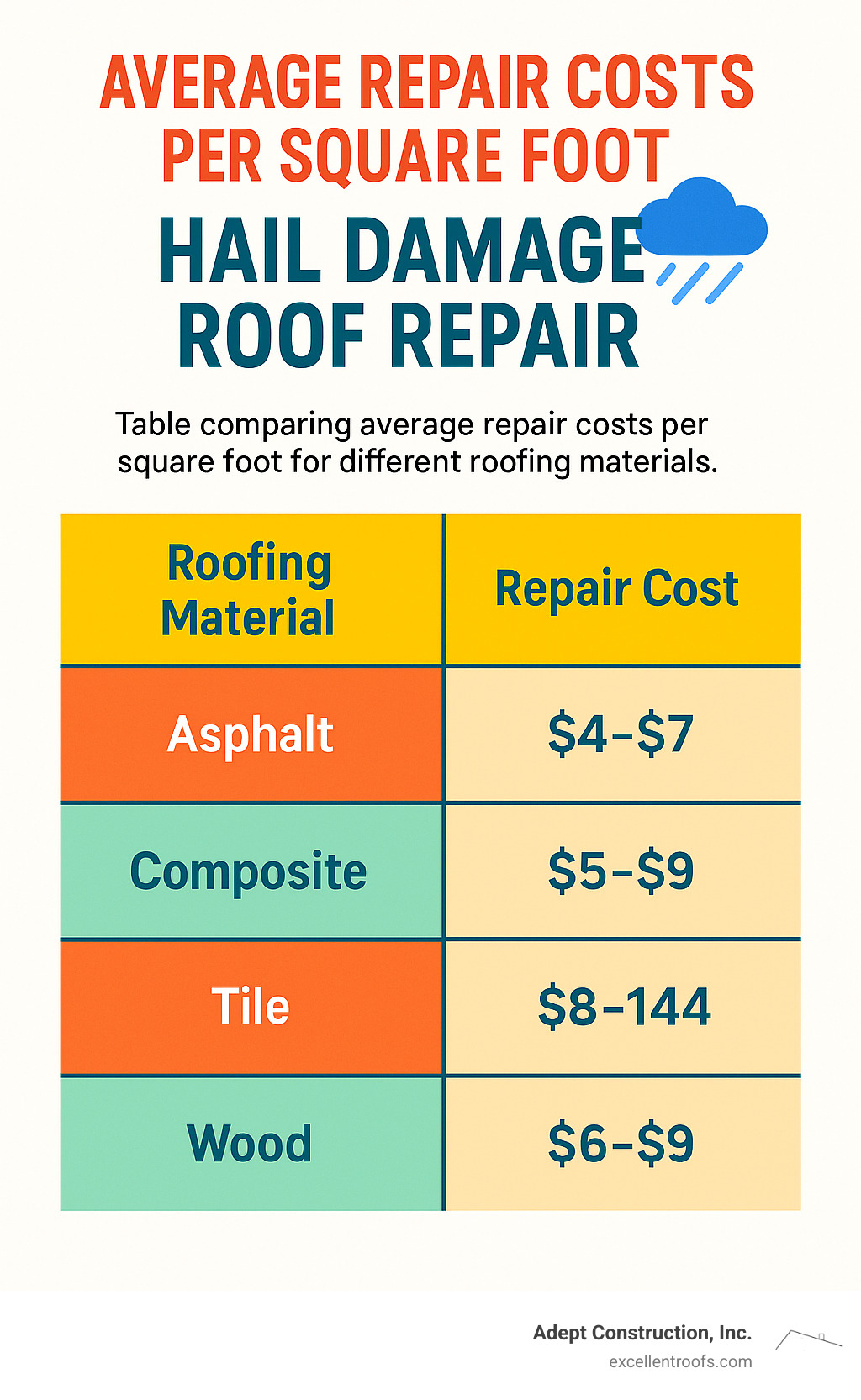
The Insurance Claim Process
Filing a claim doesn’t have to be overwhelming. Follow these steps:
- Document Everything: Take detailed photos and videos of all visible damage as soon as it’s safe.
- Contact Your Insurer Promptly: Most policies have a time limit for filing, so don’t wait.
- Schedule the Adjuster Inspection: Have your chosen roofing contractor present during the adjuster’s visit. An expert can point out damage the adjuster might miss.
- Get Multiple Estimates: Obtain written estimates from reputable contractors to ensure you’re getting a fair price and comprehensive scope of work.
- Review Your Policy: Before filing, understand your deductible and coverage limits. For more details, see our resource on Understanding your storm damage coverage.
ACV vs. RCV Policies
Understanding your policy type is critical and can mean a difference of thousands of dollars.
- Actual Cash Value (ACV): Pays the depreciated value of your roof. Like selling a used car, you get what it’s worth today, not what you paid for it. This often leaves you paying a significant portion of the replacement cost out-of-pocket.
- Replacement Cost Value (RCV): Pays to replace your roof with new materials, without deducting for depreciation. You’ll typically get an initial payment for the ACV, and the rest is paid after you submit invoices for the completed work.
Remember to factor in your deductible, which is the amount you pay before insurance coverage begins.
To Repair or Replace? Making the Right Decision for Your Home
Deciding between a patch-up and a full replacement is a major decision for your home’s protection. Here are the key considerations to help you choose the best path for your hail damage roof repair.
When to Choose Repair vs. Replacement
The choice depends on a few key factors:
- Extent of Damage: If damage is localized to a small area, a repair may suffice. If damage is widespread (e.g., 8+ hail hits per 10×10 sq ft area, a common insurance standard), a full replacement is the more practical long-term solution.
- Roof Age: An older roof near the end of its lifespan (20-30 years for asphalt) is often a better candidate for replacement after sustaining significant damage.
- Cost-Effectiveness: If the cost of multiple repairs approaches that of a replacement, a new roof offers better value.
A professional assessment is key. Our experts can help you determine if you need a simple roof repair in Naperville or a full roof replacement in Naperville. For more insight, read our guide on roof repair or replacement?
Best Roofing Materials for Hail-Prone Areas
If you live in a hail-prone area like Illinois, choosing the right material offers significant protection.
- Impact-Resistant Shingles (Class 4): These are the gold standard. UL 2218 Class 4 is the highest rating, tested to withstand impacts from 2-inch simulated hail. Many insurance companies offer premium discounts for homes with Class 4 roofs.

- Metal Roofing: While metal can dent, it is incredibly durable and rarely punctures, making it a long-lasting option.
- Composite and Rubber Roofing: High-quality composite and rubber materials are designed to absorb hail impact, offering excellent durability.
Investing in these materials can lead to a longer roof lifespan and reduced maintenance. For more technical details, you can consult resources like InterNACHI’s information on hail resistance.
Finding a Reputable Contractor for Your Hail Damage Roof Repair
After a hailstorm, you’ll see contractors knocking on doors. While some are legitimate, others are “storm chasers” looking for quick profit. Choosing the right contractor is crucial for a quality, lasting hail damage roof repair.
How to Hire a Reputable Roofer
Here’s how to separate skilled professionals from fly-by-night operations:
- Local Presence: A reputable contractor has an established local office and community roots. We are a family-owned company based in Downers Grove, serving our neighbors for decades.
- Licensed & Insured: This is non-negotiable. In Illinois, roofers must be state-licensed. Ask for proof of liability insurance and workers’ compensation to protect yourself.
- Reviews & References: Look for a solid track record on Google, Yelp, or the BBB. Ask for local references you can contact.
- Detailed Written Estimates: A professional provides a comprehensive estimate detailing the work, materials, timeline, and payment schedule. Avoid vague, handwritten quotes.
- Clear Warranties: Understand the warranties on both materials and workmanship. A contractor who stands behind their work will offer solid warranties.
- Avoid Red Flags: Be wary of demands for large upfront payments or cash-only deals. The National Insurance Crime Bureau warns about roofing fraud, so be vigilant.
Why Professional Hail Damage Roof Repair is Essential
While DIY might seem tempting, hail damage roof repair is a job for professionals for several key reasons:
- Safety: Roofing is dangerous. Professionals have the training and safety equipment to work without risking injury.
- Warranties: DIY repairs can void your roofing material warranties, a costly mistake.
- Proper Installation: Professionals have the skill to ensure repairs are properly sealed and integrated, preventing future leaks.
- Expert Assessment & Insurance Navigation: An experienced roofer spots hidden damage and can help you steer the insurance claims process effectively, ensuring your claim covers all necessary work.
For homeowners in Downers Grove, our team provides expert roof repair and roof replacement with the high-quality workmanship that has earned us strong local referrals for nearly 30 years.
Conclusion
When hailstorms strike, the path to recovery is manageable with the right knowledge and a trusted local partner. The most important thing to remember is that time is not on your side. Minor dings can quickly escalate into major water damage, turning a small repair into a costly replacement.
Your action plan is straightforward: inspect safely from the ground, document everything, contact your insurance company, and get a professional assessment. The decision to repair or replace will depend on the extent of the damage and your roof’s age, but investing in impact-resistant materials can be a smart long-term choice.
Most importantly, choose your contractor wisely. Look for an established local roofer with proper licensing, insurance, and a proven track record. Your roof protects your family and your most valuable asset.
At Adept Construction, Inc., we’ve helped families in Downers Grove and Naperville restore their peace of mind after storms since 1997. We understand that fixing a roof is about protecting what matters most.
Ready to get your roof back in top shape? Contact our team today for a comprehensive evaluation and a free estimate for your storm damage repair needs. We’re here to guide you through every step.



